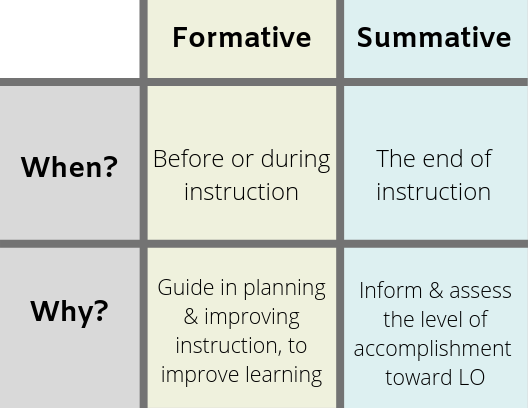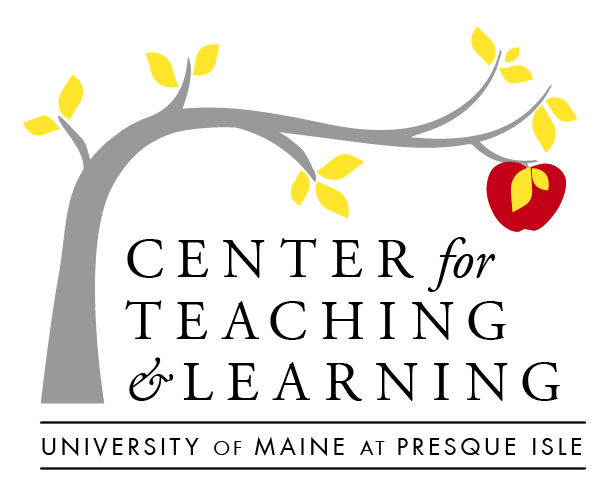
Assessment for Learning
There are many things that you will assess over the course of your semester–you may assess GLOs or PLOs, you will have CLOs to measure, and you will likely assess participation and other discipline-specific parameters. At UMPI we have a made a commitment to students that we will have transparency in how and when their learning will be assessed.
What are assessments?
- Explicit processes that provide information on student progress
- Opportunities for teachers to respond to assessment information and adjust teaching
- Opportunities for students to seek and act on feedback to make improvements
We place a large focus on formative assessment or ‘assessment for learning.’ We support the philosophy that students should be given opportunities to try new things and to build skills without the fear of one poor assessment leaving them ‘hanging in the balance.’ We want our students to take risks and to be rewarded for the journey as well as the final product.

Getting familiar with assessment types:
Assessment for Learning (Formative Assessment):
In this type of assessment, the focus is on providing specific, actionable feedback to the student so that he/she can make improvements.
This type of assessment may come in the form of:
- checking for understanding (thumbs up/down or exit tickets
- instructor observations
- feedback from low-stakes practice activities
Assessment of Learning (Summative Assessment):
In this type of assessment, the focus is on measuring student progress and achievement. Feedback is provided on how well the student performed on a particular skill or set of skills. This type of assessment is often used for grading purposes.
Examples of this type of assessment are:
- Unit or concept performative assessment, term paper or project
- Quiz or exam
Using Formative Assessment to Make Data-Informed Decisions
Creating ongoing, low-stakes formative assessment activities not only allows students to know how they are doing, but it allows you to collect and use data on what students know and can do at benchmark points throughout the course–so that you can adjust teaching and compare knowledge and skills attainment across course sections.

Attribution note: The Alternative Assessments listed were adapted from the University of Calgary Taylor Institute Resource Library, via a CC 4.0 license.
Alternative Online Assessments
There are many possibilities for alternate students assessment online such as presentations, student-created videos, and online discussions.
Open Book Exams
An open-book exam is a student assessment method designed to promote and assess higher-order learning such as critical thinking, problem-solving, synthesis and evaluation. Open book exams, or take-home exams, require students to connect course material, their own experiences, and other sources of information to solve real-world scenarios or problems
What to consider:
- Communicate to students the purpose and nature of an open book exam, along with explicit instructions such as time management, length, academic integrity, assessment criteria, timelines, and due dates.
- Focus on problem-solving, critical reasoning, and application of skills rather than foundational recall of information.
- Open-book exams can be cumulative, drawing on content from the entire course.
- Design questions that require students to identify and apply information from multiple sources, drawing on real-world scenarios.
- Connect the exam questions to the course learning outcomes to focus on student learning and set the appropriate level of challenge. Be careful not to make the exam too difficult.
- Provide student choices, such as selecting 2 out of 3 questions to answer, choice in topics, or finding additional resources as needed.
- Open exams can also be done collaboratively in small groups.
- For a timed open book exam use the D2L quiz tool or set the availability of the D2L Dropbox with a time limit.
Case Studies
A case study presents students with a real-life or hypothetical scenario that is specific to the discipline and potentially what students might face in their careers. Case studies can be multidisciplinary and provide opportunities for students to apply concepts, research and evaluate other sources of information, work in groups, and present their ideas. Cases can be simple and short to long and complex.
A quality case study has the following characteristics:
- there is no one clear answer or solution
- has sufficient information to promote a thorough analysis
- requires the student to think critically and analytically to recommend potential solutions
-
Assessment strategies for online case studies
- Post the case study in D2L and each student submits their response in the D2L dropbox.
- Present the case study in D2L and then have students work in groups using the D2L discussion board. Individual students can be assessed through their discussion contributions and submitted assignment. Students could also complete the case as groups and submit a group assignment.
- Use the D2L quiz feature to create case-based questions for students to answer.
Podcasts
A podcast is an audio narrative that uses audio recording to capture student self-expression and analytical skills in creative ways. A podcast is not a recording of a student reading a traditional paper. This assignment can be done individually (a voice memo) or collaboratively (conducting interviews).
-
What to consider
- Have students listen to sample podcasts and share their thoughts in the discussion board
- Keep it simple, have students use their phones to record a 3-5 minute podcast.
- Require students to write a script they will submit alongside their audio file.
- Use a rubric to grade their final podcast assignment
Critical Reflection
A critical reflection paper combines critical and reflective thinking skills to articulate transformative learning that is supported by course learning materials and lived experiences. A critical reflection is not a summary of reading but rather an opportunity for students to internalize and evaluate significant shifts in perspective that require openness and curiosity.
-
What to consider
- Provide examples and non-examples of critical reflection papers for students to read
- Use the discussion board to encourage conversation and questions about the papers
- Remind students to avoid thinking of this assignment as a diary entry
- Have students submit their critical reflection assignment via Brightspace
Concept Map
A concept map is a visual organization and representation of how different concepts or ideas are intertwined and connected. It is a visual teaching tool to organize and structure knowledge to deepen understanding and comprehension. Concept maps can also be used to assess students’ knowledge and comprehension of abstract and complex concepts.
What to consider:
-
- It could be an individual assignment or a collaborative group assignment.
- Students could draw concept maps using pens and paper or create maps digitally.
- Get students to write a short paragraph explaining the concept map they’ve created or reflecting on the process.
- Provide specific instructions and expectations such as a grading rubric for this assignment.
Infographics
An infographic is a visual representation of information, including charts, diagrams, pictures and icons that are used with text and color to convey that information in a way that makes it easy for viewers to understand. When students create infographics, it requires them to analyze information, select the most salient content, and decide how to convey it to others. The infographic can be submitted alone or along with a short written paper in which the student outlines their decision-making process.
Finished assignments can be posted to a discussion board or used in an online student presentation.
Examples of student-created infographics: https://ederprojects.weebly.com/infographics.html
Annotated Bibliography
An annotated bibliography assignment requires students to summarize the most salient literature on a course topic, making it a good choice for learning one topic in depth. Students develop skills in locating relevant literature, analyzing the quality of articles, understanding the arguments being made, and summarizing them in a brief description.
Example assignment guidelines:
Media Critique
Critiquing a current news article can be a meaningful learning experience as news articles are relevant and provide an opportunity for critical analysis. Students will need to either critique a selected news article or find one based on specific criteria to critique. This type of assignment can be used to assess students’ ability to identify credible news sources, research and provide other sources of supporting or contradicting information, express and justify their positions, and clearly communicate their ideas.
-
What to consider
- Provide examples of a news article critique and use the discussion board to discuss the elements of a good critique and news source. – Post a rubric or assessment criteria to help guide students’ work
- Break the class into small discussion groups to provide each other with peer feedback
- Use Brightspace for students to submit their assignment
- Give students the option of using media to complete their assignment (such as recording a video or creating an infographic)
Online Discussions
Online discussions provide affordances for students to brainstorm ideas or work on projects collaboratively, share their work, and reflect on the learning process. Different activities could be designed and implemented in online discussions to promote analytical and critical thinking. Start with a question or a prompt from the readings, the News, or a video, and ask students to post an original thought and response to at least one other classmate’s comment.
- Online discussion rubric by Dr. Susan Wegmann, Professor of Education and the Director of Program Development and Special Programs at the Baptist College of Florida
- Online discussion participation rubric by Dr. Kelvin Thompson
- Designing and Orchestrating Online Discussions by David Baker (2011)
- The methods and means to grading student participation in online discussions
- Online discussion forum grading rubric
- Sample discussion board rubric LDT
Oral presentations
Online oral assessments, like face-to-face oral assessments, are used to evaluate student learning through spoken language. These include individual interviews, group discussions, stand-alone exams as well as complementary or supplementary exams related to a written assessment.
-
What to consider
- Oral assessments that are clearly aligned with learning outcomes can support and evaluate higher-order thinking such as the application of theory and problem-solving.
- They can also be used in conjunction with written assessments such as multiple-choice tests on basic knowledge and understanding. Example: Midterm Part A – multiple choice test on basic facts and Midterm Part B – oral exam on theoretical understanding and application.
- Instructors and TAs are encouraged to use a rubric and jointly assess responses to ensure greater transparency and consistency. Ensure students are familiar with the rubric prior to the assessment.
- Carefully consider possible equity concerns for those with unreliable internet access, anxiety disorders, language considerations, hearing challenges, etc.
- Create an exam script to ensure that all students are given the same instructions and prompts. This information may also be sent out ahead of time so that students know what materials they may/may not have on hand: eg., pen and paper, notes, calculator, text, etc.
- To enhance academic integrity, you may want to have a question bank to randomize questions. You may also have students make a verbal statement of commitment to academic integrity, such as “I agree to abide by the University of Calgary’s commitment to honest and responsible scholarship by using only authorized materials during my exam. All answers are my own. I will keep exam questions confidential and not share them with other students.”
- Plan technology details carefully: will each student have a different Zoom link or wait in the waiting room for their turn? Will all participants need to have cameras on? How will sound levels, etc. be tested?
- Also, create contingency plans in case of technology or internet problems that may occur mid-assessment.
